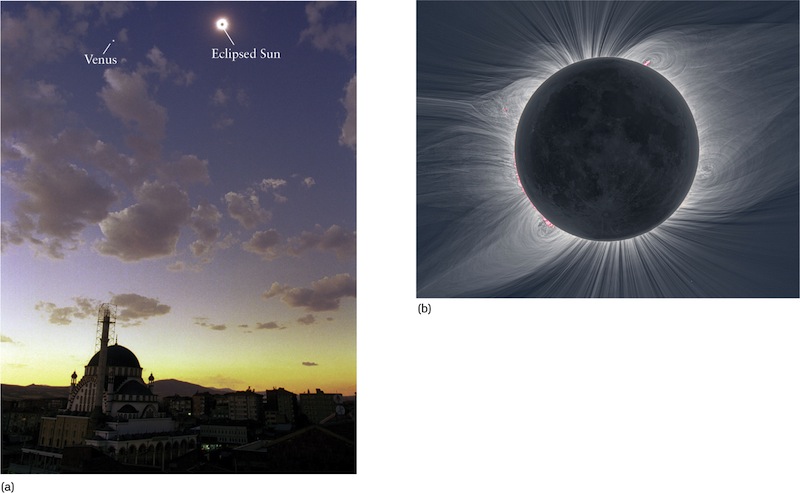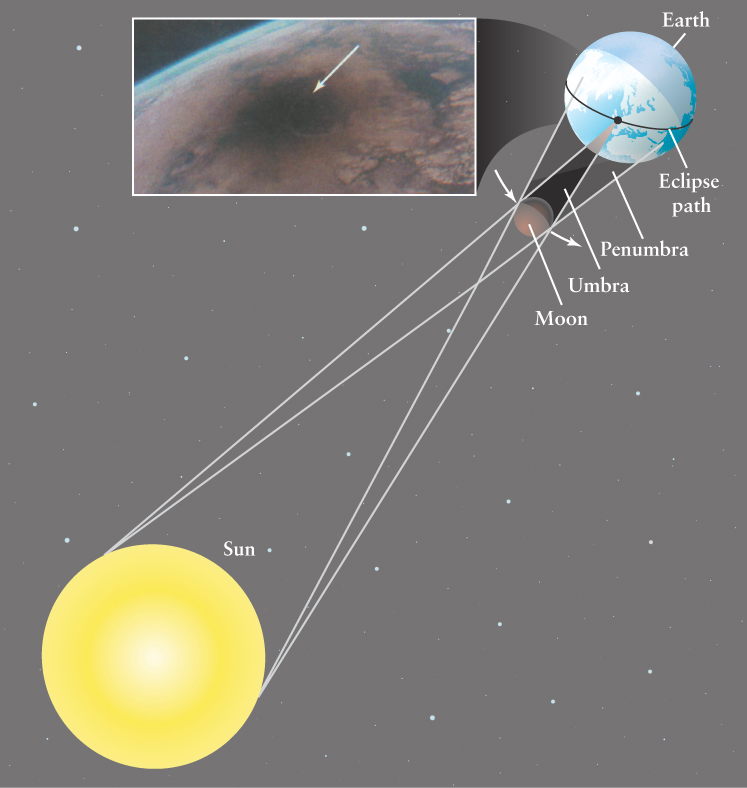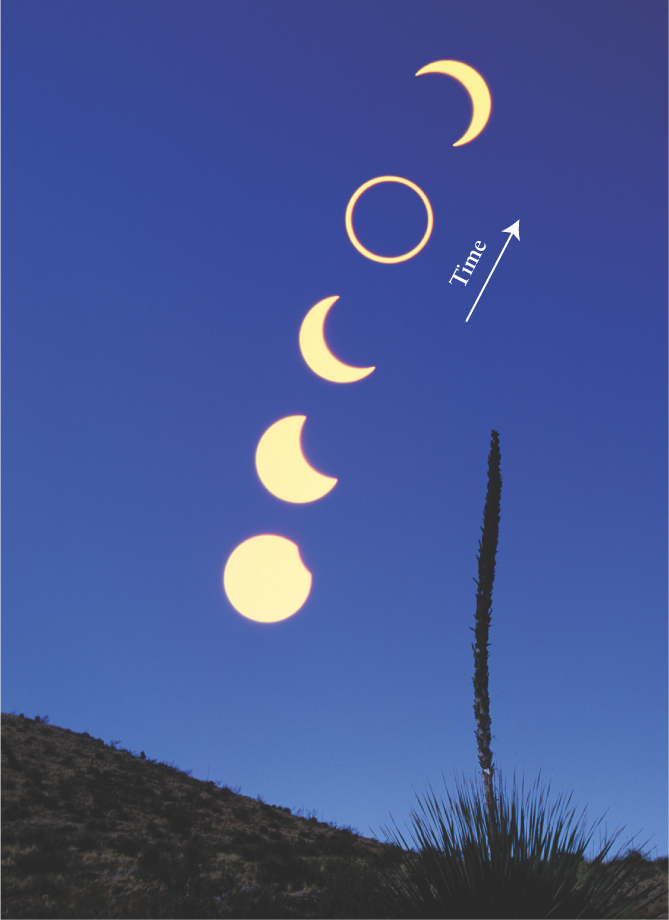3-5 Solar eclipses also depend on the alignment of the Sun, Earth, and Moon
 As seen from Earth, the angular diameter of the Moon is almost exactly the same as the angular diameter of the far larger but more distant Sun—about 0.5°. Thanks to this coincidence of nature, the Moon just “fits” over the Sun during a total solar eclipse.
As seen from Earth, the angular diameter of the Moon is almost exactly the same as the angular diameter of the far larger but more distant Sun—about 0.5°. Thanks to this coincidence of nature, the Moon just “fits” over the Sun during a total solar eclipse.
Total Solar Eclipses
A lunar eclipse is most impressive when total, but can also be partial or penumbral
A total solar eclipse is a dramatic event. The sky begins to darken, the air temperature falls, and winds increase as the Moon gradually covers more and more of the Sun’s disk. All nature responds: Birds go to roost, flowers close their petals, and crickets begin to chirp as if evening had arrived. As the last few rays of sunlight peek out from behind the edge of the Moon and the eclipse becomes total, the landscape around you is bathed in an eerie gray or, less frequently, in shimmering bands of light and dark. Finally, for a few minutes the Moon completely blocks out the dazzling solar disk (Figure 3-10a). The solar corona—the Sun’s thin, hot outer atmosphere, which is normally too dim to be seen—blazes forth in the darkened daytime sky (Figure 3-10b). It is an awe-inspiring sight.

A Total Solar Eclipse (a) This photograph shows the total solar eclipse of August 11, 1999, as seen from Elâziğ, Turkey. The sky is so dark that the planet Venus can be seen to the left of the eclipsed Sun. (b) When the Moon completely covers the Sun’s disk during a total eclipse, the faint solar corona is revealed.
CAUTION!
If you are fortunate enough to see a solar eclipse, keep in mind that the only time when it is safe to look at the Sun is during totality, when the solar disk is blocked by the Moon and only the solar corona is visible. Viewing this magnificent spectacle cannot harm you in any way. But you must never look directly at the Sun when even a portion of its intensely brilliant disk is exposed. If you look directly at the Sun at any time without a special filter approved for solar viewing, you will suffer permanent eye damage or blindness.
To see the remarkable spectacle of a total solar eclipse, you must be inside the darkest part of the Moon’s shadow, also called the umbra, where the Moon completely blocks the Sun. Because the Sun and the Moon have nearly the same angular diameter as seen from Earth, only the tip of the Moon’s umbra reaches Earth’s surface (Figure 3-11). As Earth rotates, the tip of the umbra traces an eclipse path across Earth’s surface. Only those locations within the eclipse path are treated to the spectacle of a total solar eclipse. The inset in Figure 3-11 shows the dark spot on Earth’s surface produced by the Moon’s umbra.
57

 The Geometry of a Total Solar Eclipse During a total solar eclipse, the tip of the Moon’s umbra reaches Earth’s surface. As Earth and the Moon move along their orbits, this tip traces an eclipse path across Earth’s surface. People within the eclipse path see a total solar eclipse as the tip moves over them. Anyone within the penumbra sees only a partial eclipse. The inset photograph was taken from the Mir space station during the August 11, 1999, total solar eclipse (the same eclipse shown in Figure 3-10). The tip of the umbra appears as a black spot on Earth’s surface. At the time the photograph was taken, this spot was 105 km (65 mi) wide and was crossing the cloud-covered English Channel at 3000 km/h (1900 mi/h).
The Geometry of a Total Solar Eclipse During a total solar eclipse, the tip of the Moon’s umbra reaches Earth’s surface. As Earth and the Moon move along their orbits, this tip traces an eclipse path across Earth’s surface. People within the eclipse path see a total solar eclipse as the tip moves over them. Anyone within the penumbra sees only a partial eclipse. The inset photograph was taken from the Mir space station during the August 11, 1999, total solar eclipse (the same eclipse shown in Figure 3-10). The tip of the umbra appears as a black spot on Earth’s surface. At the time the photograph was taken, this spot was 105 km (65 mi) wide and was crossing the cloud-covered English Channel at 3000 km/h (1900 mi/h).
Partial Solar Eclipses
Immediately surrounding the Moon’s umbra is the region of partial shadow called the penumbra. As seen from this area, the Sun’s surface appears only partially covered by the Moon. During a solar eclipse, the Moon’s penumbra covers a large portion of Earth’s surface, and anyone standing inside the penumbra sees a partial solar eclipse. Such eclipses are much less interesting events than total solar eclipses, which is why astronomy enthusiasts strive to be inside the eclipse path. If you are within the eclipse path, you will see a partial eclipse before and after the brief period of totality (see the photograph that opens this chapter).
The width of the eclipse path depends primarily on the Earth-Moon distance during totality. The eclipse path is widest if the Moon happens to be at perigee, the point in its orbit nearest Earth. In this case the width of the eclipse path can be as great as 270 kilometers (170 miles). In most eclipses, however, the path is much narrower.
CONCEPT CHECK 3-8
Why can a total lunar eclipse be seen by people all over the world whereas total solar eclipses can only be seen from a very limited geographic region?
Annular Solar Eclipses
In some eclipses the Moon’s umbra does not reach all the way to Earth’s surface. This can happen if the Moon is at or near apogee, its farthest position from Earth. In this case, the Moon appears too small to cover the Sun completely. The result is a third type of solar eclipse, called an annular eclipse. During an annular eclipse, a thin ring of the Sun is seen around the edge of the Moon (Figure 3-12). The length of the Moon’s umbra is nearly 5000 kilometers (3100 miles) less than the average distance between the Moon and Earth’s surface. Thus, the Moon’s shadow often fails to reach Earth even when the Sun, Moon, and Earth are properly aligned for an eclipse. Hence, annular eclipses are slightly more common—as well as far less dramatic—than total eclipses.

An Annular Solar Eclipse This composite of six photographs taken at sunrise in Costa Rica shows the progress of an annular eclipse of the Sun on December 24, 1973. Note that at mideclipse the limb, or outer edge, of the Sun is visible around the Moon.
58
Even during a total eclipse, most people along the eclipse path observe totality for only a few moments. Earth’s rotation, coupled with the orbital motion of the Moon, causes the umbra to race eastward along the eclipse path at speeds in excess of 1700 kilometers per hour (1060 miles per hour). Because of the umbra’s high speed, totality never lasts for more than 7½ minutes. In a typical total solar eclipse, the Sun-Moon-Earth alignment and the Earth-Moon distance are such that totality lasts much less than this maximum.
The details of solar eclipses are calculated well in advance. They are published in such reference books as the Astronomical Almanac and are available on the World Wide Web. Figure 3-13 shows the eclipse paths for all total solar eclipses from 1997 to 2020. Table 3-2 lists all the total, annular, and partial eclipses from 2012 to 2015, including the maximum duration of totality for total eclipses.

| Date | Type | Where visible | Notes |
|---|---|---|---|
| 2012 May 20 | Annular | Asia, Pacific, North America | 94% eclipsed |
| 2012 Nov 13 | Total | Australia, New Zealand, southern Pacific, southern South America | Maximum duration of totality 4m 02s |
| 2013 May 10 | Annular | Australia, New Zealand, central Pacific | Maximum duration of 06m 03s |
| 2013 Nov 03 | Total/Annular | Eastern Americas, southern Europe, Africa | Rare hybrid eclipse with maximum duration of 1m 40s |
| 2014 Apr 29 | Annular | Southern Indian Ocean, Australia, Antarctica | 98% eclipsed |
| 2015 Mar 20 | Total | Iceland, Europe, northern Africa, northern Asia | Maximum duration of 02m 47s |
| 2015 Sep 13 | Partial | Southern Africa, southern Indian Ocean, Antarctica | 79% eclipsed |
| Eclipse predictions by Fred Espenak, NASA/Goddard Space Flight Center. | |||
Ancient astronomers achieved a limited ability to predict eclipses. In those times, religious and political leaders who were able to predict such awe-inspiring events as eclipses must have made a tremendous impression on their followers. One of three priceless manuscripts to survive the devastating Spanish Conquest shows that the Mayan astronomers of Mexico and Guatemala had a fairly reliable method for predicting eclipses. The great Greek astronomer Thales of Miletus is said to have predicted the famous eclipse of 585 b.c.e., which occurred during the middle of a war. The sight was so unnerving that the soldiers put down their arms and declared peace.
In retrospect, it seems that what ancient astronomers actually produced were eclipse “warnings” of various degrees of reliability rather than true predictions. Working with historical records, these astronomers generally sought to discover cycles and regularities from which future eclipses could be anticipated. Box 3-2 describes how you might produce eclipse warnings yourself.
CONCEPT CHECK 3-9
If you had a chance to observe a total solar eclipse and a total lunar eclipse, in general, how much longer would you expect one type to last than the other?